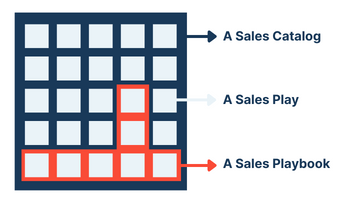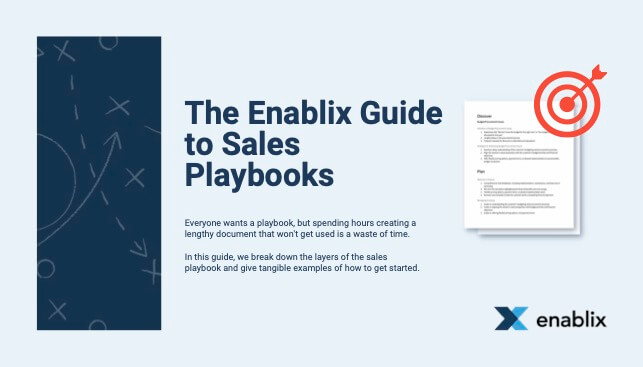Stuck on Playbooks?
Sales playbooks have been seen as an essential sales tool for quite some time, but that status certainly hasn’t kept them from being complicated and misunderstood. At this point, the term “playbook” has become somewhat of a catch-all term that gets used in different ways, but generally means a resource to help reps move the sales cycle in a given situation.
In our newest eBook/guide, we break down why Playbooks aren’t actually the starting point for teams trying to guide reps into corrective action, and why sales plays are the necessary building block for teams trying to create a library of best practices.
In this guide, we set out to help the everyday enabler that needs to put together helpful resources for their team, but isn’t sure where to start. We’ll cover what makes a “good” playbook, the layers of the playbook, and how to get started and measure progress along the way.
Download the Guide below, and keep reading for highlights about the benefits of effective sales playbooks and actionable steps you can take to start making your own effective playbooks!
Do Sales Reps Really Need Playbooks?
First things first – why even build playbooks?
It might sounds silly, but diving into playbooks without a firm understanding of the intended benefits can have your efforts go sideways on you quickly. At a high level, playbooks will provide three different areas of value for your revenue team:
Alignment: Do we Agree How to Sell?
The process of discussing and building a playbook will create better alignment for your team when it comes to your sales strategy. It’s not atypical for different members of the revenue organization to have wildly different opinions on the best way to sell and gain revenue for your product – creating a definitive guide through a scenario creates alignment between these stakeholders on what the best way through a situation is.
This guide should combine sales processes and sales execution in a way that best matches the buyer’s journey. So opening up conversations about what that looks like for each of your team members will help not only achieve alignment, but make sure that everyone knows the best steps to take in a given scenario. You can’t have a playbook if everyone disagrees, so this is a guaranteed way to get everyone on the same page.

Positioning: Are we Saying the Right things?
The playbook will outline what a sales rep should ideally be saying and doing according to your positioning. During these playbook discussions, gauging how this is perceived by the team will let you know how close your ideal positioning is to what is actually being said on sales calls.
Following up with and checking in with how prospects are responding to this will also give you insights into how your positioning resonates with the market.
Repeatability: Can we Scale this process?
Whether you’re in a well-functioning enterprise organization or simply trying to scale a business, you want the actions of your revenue-facing team members to be easily repeatable. Having repeatable actions means that outcomes are more consistent and predictable, making it easier to grow and scale.
A common and standard guide, like the playbook, is going to create that repeatability because it gives reps the specific actions to take in different scenarios. When this is all written down, it becomes easier to repeat the behaviors that work. This also helps ensure your reps aren’t going off-brand or opening/closing conversations with things your product doesn’t do.
Layers of the Playbook
Now that we’ve established why playbooks are an important tool for not only your reps, but the entire org, let’s talk about how to actually make them.
There are 3 essential layers to the playbook:
- The Sales Play: a strategy created based on specific situations
- The Sales Playbooks: a collection of plays for an industry or group
- The Sales Catalog: all the sales materials in one place for easy searching
A common problem for enablers setting out to create playbooks is that they start by trying to create an all-encompassing playbook, only to end up with a long 20 page document that no one will use.
A better way to start is with real, tangible problem scenarios that your team is facing and create sales plays focusing on those real situations. Creating these plays is easier and more effective than starting with the full playbook, and once you’ve created a collection of plays, the playbook will effectively create itself, along with the entire sales catalog.

The playbook is made up of individual plays and sits within the sales catalog
Nailing the Sales Play
Interested in nailing sales plays and creating playbooks that get adoption? Download the guide below to learn the key steps to creating a repeatable sales process:
Download The Full Guide Now




